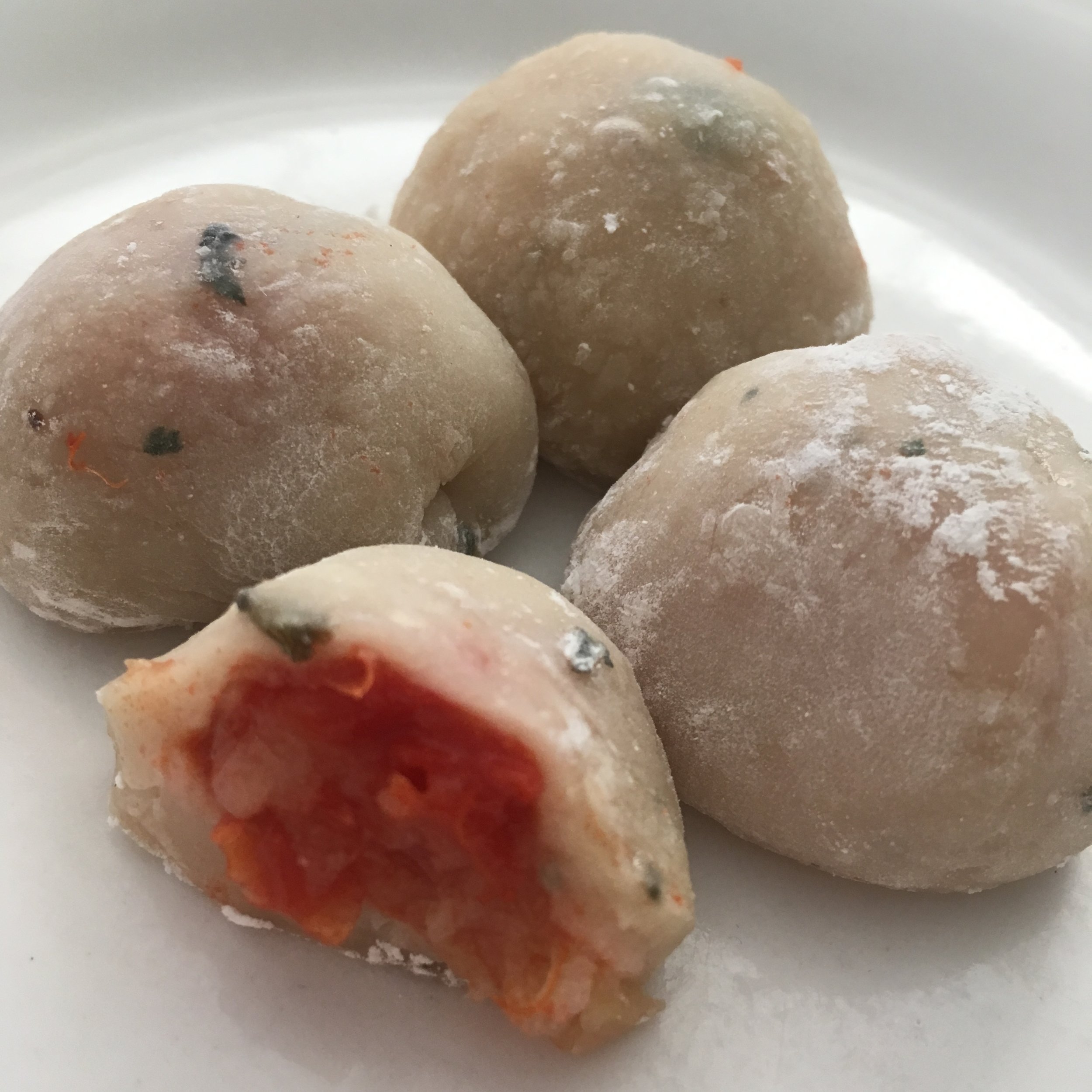Mochi with rosehip and pear stuffing. I used nettle to make this mochi, which is much less green.
I absolutely love the podgy, glutinous Japanese sweet known as ‘mochi’(餅), it has the strangest but most satisfying texture to eat. It isn’t too sweet, it’s simple and quick to make (just four ingredients) and it contains one of my favourite herbs - Mugwort. In Japan, the species used is Artemisia princeps but I used the closely related, native species to the UK: Artemisia vulgaris. They both keep a bright green colour when infused that is used for colouring the mochi. I explain a little about mugwort here, but skip to the bottom for the recipe and the picture instructions.
Mugwort: the moon herb
Mugwort (Artemisia vulgaris) is a herb with fabulous magical folklore, it’s latin name - ‘Artemisia’ is said to refer to Artemis, the Ancient Greek goddess of the the moon, wilderness, hunting and childbirth. It is used medicinally by traditional western herbalists for regulating the menstrual cycle (to the moon cycle). It was also used to bring on delayed menses, so should not be used in large medicinal amounts by pregnant women, particularly in the first trimester.
The aromatic oils contained in the leaves are a bitter digestive and are also strongly antibacterial. Mugwort is one of the 9 healing wound herbs recorded in the ‘Ley of the nine herbs’ recorded in the Lacnunga, an Anglo Saxon manuscript (circa 1000AD). Mugwort infusion, infused oil or tincture can be added to wound healing recipes. A translation of the 9 herbs poem gives these lines:
Remember, Mugwort, what you revealed,
What you set out in mighty revelation,
‘Una’ you are called, oldest of plants,
You have might against three and against thirty,
You have might against poison and against infection,
You have might against the evil that travels around the land.
(Pollington, 2008)
Mugwort is also used in dreamwork with scented pillows made from the flowers, and infusions of the leaves are used to increase lucid dreaming.
Harvesting
Mugwort leaves showing silvery underside. The flower stalk on the right is a little too brown and gone over for best use, but still tasted good.
For medicinal use, mugwort leaves and flower stalks are best gathered at the height of summer when the young flowers are at their most aromatic and still green. This is perfect for making infusions for medicnal uses and infused dream oils and balms.
Edit: it is the young spring leaves and the the autumnal second flush of leaves that are best used for mochi making. Thanks to @Littlelilly_godvalley who let us know on instagram.
Mugwort is a tall plant with heavily lobed dark green leaves with a silvery underside. Get a good ID book to see what it looks like as it is a shy plant and it is hard to get a good photo of it in the wild. Always be 100% sure you have picked the correct plant before eating.
Making Mochi
Though I have a much quicker recipe for making mochi below, the traditional method uses a lot of muscle power to pound rice into the sweet, glutinous paste that forms the base of the recipe. A fascinating (short!) video about this can be seen here, courtesy of Great big Story.
Sweet Mugwort Mochi Recipe
The important ingredient in this recipe is the glutinous rice powder. It must be glutinous rice powder, as regular rice powder will not work. It is quite cheap and a little goes a long way. I tried a few recipes but found this one to be the simplest adapted from snapguide**. I have added a gallery of pictures below of how each stage looks.
110g glutinous rice powder
55g sugar
180 mls water
1 cup of chopped fresh mugwort leaves and flowers (estimated amount!)
cornflour to coat
Step-by-step pictures below.
You don’t have to add a filling your mochi, just slice into bite sized pieces, or roll into little balls.
Place about 200mls water and the mugwort herb in a pan over a medium heat. Bring to a boil, then reduce to a simmer and place on the lid. Cook for 5 minutes. Remove the mixture form the heat and pour into a blender. Whizz up the herb and liquid well. Strain out the herb and measure out 180mls of the green liquid. (If you have simmered off too much liquid, add a little extra water). If you like, you can add a couple of tablespoons of the leftover mugwort herb to add the mixture.
In a heat proof glass bowl, mix together the glutinous rice powder and sugar. Add 180mls of the mugwort liquid into the bowl, whisking briskly into the rice-sugar mix. This will make a fairly liquid mixture.
Take the same bowl with the liquid mix and either suspend it over a pan of gently simmering water, or place the bowl in a steamer rack over a pan. Place a lid wrapped in a tea-towel over the bowl to prevent steam dripping in and spoiling the mixture.
Steam for 5 minutes, then remove lid and stir, scraping the mixture down the sides to the middle.. The mixture will be lumpy. Return to the pan and cover again. Steam for another 10 minutes. The mixture should now be a consistent translucent gel texture throughout, though it may appear lumpy until kneaded. If not translucent, give it a stir and steam for a couple minutes more.
Remove the bowl from the pan, and carefully scrape out the mixture onto a cornflour coated worktop. Allow to cool enough to handle. Cover your blob of mochi with cornflour and roll out to desired thickness (0.5-1cm). These can be cut into squares to eat alone, or use a biscuit cutter to make circles to wrap a filling.
SHELF LIFE: keep in the fridge and eat within 3 days. Alternatively, freeze for later use for up to 3 months.
However, mochi is usually stuffed with red bean paste. Instead, try hedgerow purees using elderberry, rosehip, hawthorn…. let me know if you create a good filling.
Picture guide for recipe
Strain off the mochi liquid
Whisk the liquid briskly into the dry mixture
The mixture will be liquid with the consistency of double cream
Steaming the mochi mixture with tea-towel wrapped lid
Texture after 5 minutes
Springy, translucent texture after 15 minutes
Place on a cornflour coated worktop and allow to cool slightly
Cover with cornflour and roll out
Cut into circles ready for filling
*Excerpt taken from: Pollington, S., (2008). Leechcraft: old English charms, plantlore and healing. Ely: Anglo- Saxon Books.













